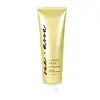What's inside
What's inside
 Key Ingredients
Key Ingredients

 Benefits
Benefits

 Concerns
Concerns

 Ingredients Side-by-side
Ingredients Side-by-side

Water
Skin ConditioningPumice
AbrasiveSodium Cocoamphoacetate
CleansingLauryl Glucoside
CleansingSodium Cocoyl Glutamate
CleansingSodium Lauryl Glucose Carboxylate
CleansingCaprylic/Capric Triglyceride
MaskingIsopropyl Palmitate
EmollientStearyl Alcohol
EmollientCetyl Alcohol
EmollientGlycerin
HumectantAcrylamide/Sodium Acryloyldimethyltaurate Copolymer
Emulsion StabilisingParaffinum Liquidum
EmollientTrideceth-6
EmulsifyingSteareth-2
EmulsifyingSteareth-21
CleansingCarbomer
Emulsion StabilisingBehenyl Alcohol
EmollientCocos Nucifera Oil
MaskingGardenia Taitensis Flower Extract
Skin ConditioningMacrocystis Pyrifera Extract
Skin ConditioningVaccinium Angustifolium Fruit Extract
Skin ProtectingRosmarinus Officinalis Leaf Extract
AntimicrobialButyrospermum Parkii Butter
Skin ConditioningPhenoxyethanol
PreservativeDehydroacetic Acid
PreservativeBenzyl Alcohol
PerfumingCI 15985
Cosmetic ColorantCI 16035
Cosmetic ColorantCI 14700
Cosmetic ColorantWater, Pumice, Sodium Cocoamphoacetate, Lauryl Glucoside, Sodium Cocoyl Glutamate, Sodium Lauryl Glucose Carboxylate, Caprylic/Capric Triglyceride, Isopropyl Palmitate, Stearyl Alcohol, Cetyl Alcohol, Glycerin, Acrylamide/Sodium Acryloyldimethyltaurate Copolymer, Paraffinum Liquidum, Trideceth-6, Steareth-2, Steareth-21, Carbomer, Behenyl Alcohol, Cocos Nucifera Oil, Gardenia Taitensis Flower Extract, Macrocystis Pyrifera Extract, Vaccinium Angustifolium Fruit Extract, Rosmarinus Officinalis Leaf Extract, Butyrospermum Parkii Butter, Phenoxyethanol, Dehydroacetic Acid, Benzyl Alcohol, CI 15985, CI 16035, CI 14700
Water
Skin ConditioningSodium C14-16 Olefin Sulfonate
CleansingSodium Chloride
MaskingCocamidopropyl Betaine
CleansingPumice
AbrasiveAnanas Sativus Fruit Extract
Skin ConditioningMangifera Indica Fruit Extract
Skin ConditioningSodium Cocoamphoacetate
CleansingGlycerin
HumectantLauryl Glucoside
CleansingSodium Cocoyl Glutamate
CleansingSodium Lauryl Glucose Carboxylate
CleansingDecyl Glucoside
CleansingSodium Lauroyl Sarcosinate
CleansingJuglans Regia Shell Powder
AbrasiveCarbomer
Emulsion StabilisingPEG-150 Distearate
EmulsifyingPhenoxyethanol
PreservativeDehydroacetic Acid
PreservativeBenzyl Alcohol
PerfumingLimonene
PerfumingParfum
MaskingSodium Hydroxide
BufferingWater, Sodium C14-16 Olefin Sulfonate, Sodium Chloride, Cocamidopropyl Betaine, Pumice, Ananas Sativus Fruit Extract, Mangifera Indica Fruit Extract, Sodium Cocoamphoacetate, Glycerin, Lauryl Glucoside, Sodium Cocoyl Glutamate, Sodium Lauryl Glucose Carboxylate, Decyl Glucoside, Sodium Lauroyl Sarcosinate, Juglans Regia Shell Powder, Carbomer, PEG-150 Distearate, Phenoxyethanol, Dehydroacetic Acid, Benzyl Alcohol, Limonene, Parfum, Sodium Hydroxide
Ingredients Explained
These ingredients are found in both products.
Ingredients higher up in an ingredient list are typically present in a larger amount.
Benzyl Alcohol is most commonly used as a preservative. It also has a subtle, sweet smell. Small amounts of Benzyl Alcohol is not irritating and safe to use in skincare products. Most Benzyl Alcohol is derived from fruits such as apricots.
Benzyl Alcohol has both antibacterial and antioxidant properties. These properties help lengthen the shelf life of products. Benzyl Alcohol is a solvent and helps dissolve other ingredients. It can also improve the texture and spreadability.
Alcohol comes in many different forms. Different types of alcohol will have different effects on skin. This ingredient is an astringent alcohol.
Using high concentrations of these alcohols are drying on the skin. They may strip away your skin's natural oils and even damage your skin barrier. Astringent alcohols may also irritate skin.
Other types of astringent alcohols include:
According to the National Rosacea Society based in the US, you should be mindful of products with these alcohols in the top half of ingredients.
Any type of sanitizing product will have high amounts of alcohol to help kill bacteria and viruses.
Learn more about Benzyl AlcoholCarbomer is a polymer of acrylic acid. Its main role is to create a gel consistency.
A high amount of carbomer can cause pilling or balling up of products. Don't worry, most products contain 1% or less of carbomer.
Dehydroacetic Acid is fungicide and bactericide. It is used as a preservative in cosmetics. Preservatives help elongate the shelf life of a product.
Dehydroacetic Acid is not soluble in water.
Glycerin is already naturally found in your skin. It helps moisturize and protect your skin.
A study from 2016 found glycerin to be more effective as a humectant than AHAs and hyaluronic acid.
As a humectant, it helps the skin stay hydrated by pulling moisture to your skin. The low molecular weight of glycerin allows it to pull moisture into the deeper layers of your skin.
Hydrated skin improves your skin barrier; Your skin barrier helps protect against irritants and bacteria.
Glycerin has also been found to have antimicrobial and antiviral properties. Due to these properties, glycerin is often used in wound and burn treatments.
In cosmetics, glycerin is usually derived from plants such as soybean or palm. However, it can also be sourced from animals, such as tallow or animal fat.
This ingredient is organic, colorless, odorless, and non-toxic.
Glycerin is the name for this ingredient in American English. British English uses Glycerol/Glycerine.
Learn more about GlycerinLauryl Glucoside sugar- and lipid-based cleansing agent. It is created from glucose and lauryl alcohol.
This ingredient is a surfactant, making it easier to rinse oil, dirt, and other pollutants away.
A British study found lauryl glucoside to cause skin sensitivity for some people. We recommend speaking with a professional if you have concerns.
Other names for this ingredient include "Lauryl Polyglucose", "Lauryl glycoside", and "D-Glucopyranoside".
Learn more about Lauryl GlucosidePhenoxyethanol is a preservative that has germicide, antimicrobial, and aromatic properties. Studies show that phenoxyethanol can prevent microbial growth. By itself, it has a scent that is similar to that of a rose.
It's often used in formulations along with Caprylyl Glycol to preserve the shelf life of products.
Pumice is an exfoliant.
We don't have a description for Sodium Cocoamphoacetate yet.
Sodium Cocoyl Glutamate is a gentle cleanser and surfactant. It is the sodium salt of the Cocoyl Glutamic Acid and comes from coconut oil. As a surfactant, it helps lift dirt and oil to be washed away.
Sodium Cocoyl Glutamate also has an emolliating effect and can help leave the skin feeling soft.
We don't have a description for Sodium Lauryl Glucose Carboxylate yet.
Water. It's the most common cosmetic ingredient of all. You'll usually see it at the top of ingredient lists, meaning that it makes up the largest part of the product.
So why is it so popular? Water most often acts as a solvent - this means that it helps dissolve other ingredients into the formulation.
You'll also recognize water as that liquid we all need to stay alive. If you see this, drink a glass of water. Stay hydrated!
Learn more about Water